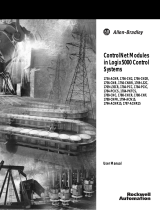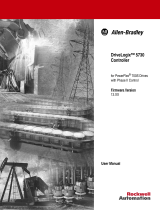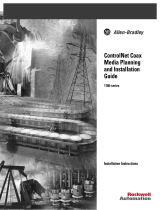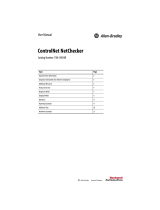Page is loading ...

Publication 1788-IN002C-EN-P - April 2004
Installation Instructions
ControlNet Daughtercard
Catalog Numbers 1788-CNC and 1788-CNCR
This document describes how to install and configure the ControlNet 1788-CNC and
-CNCR daughtercards. In this document, we use the term ‘the card’ to refer to both
daughtercards collectively. When one card is different from the other, we refer to the
daughtercard by name.
If you are connecting the card directly to a ControlNet network, you should also refer to these
publications:
• ControlNet Tap Installation Instructions, publication 1786-5.7
• ControlNet Coax Media Planning and Installation Guide, publication CNET-IN002
For information about See page
Important User Information 2
European Hazardous Location Approval 4
North American Hazardous Location Approval 5
About the Daughtercards 6
Setting the Node Address 7
Installing the Card 8
Daughtercard Performance 8
Connecting the Card to the Network 8
Connect to the Network Using a Tap 10
Connect to the Network Using a 1786-CP Cable 12
Interpreting the Status Indicators 14
Specifications 17

6 ControlNet Daughtercard
Publication 1788-IN002C-EN-P - April 2004
About the Daughtercards
The network daughtercard architecture defines a common
hardware and software interface that several different
network interface cards will support. This allows products
that have been designed to support the network
daughtercard option to support several different Rockwell
Automation networks.
About the ControlNet Daughtercard
You can install the 1788-CNC or -CNCR ControlNet daughtercard in any host device that
supports the ControlNet daughtercard.
(1)
Every ControlNet network requires at least one module that is able to store parameters and
configure the network with those parameters upon start-up. This module is called a ‘keeper’
since it keeps the network configuration.
Any 1788-CNC or -CNCR card can keep the network parameters at any legal node address
(01 to 99). Multiple devices on any one network can act as the network keeper. Each device
capable of being the network keeper acts to back up the current keeper. This backup function
is automatic and requires no action on your part.
WARNING
• If you connect or disconnect the communications cable with
power applied to this module or any device on the network, an
electrical arc can occur. This could cause an explosion in
hazardous location installations.
• If you insert or remove the card while host power is on, an
electrical arc can occur. This could cause an explosion in
hazardous location installations.
• Be sure that power is removed or the area is nonhazardous
before proceeding.
(1)
The host device must provide a suitable power source per the restrictions in the specifications table.
IMPORTANT
On the 1788-CNC or -CNCR card, the non-volatile keeper data is erased
when a firmware update is performed.

ControlNet Daughtercard 7
Publication 1788-IN002C-EN-P - April 2004
Setting the Node Address
You must set two switch assemblies to configure the daughtercard with its unique network
address. Figure 1 shows the location of the switches. These switches are read on powerup to
establish the network address of the card.
Set the node address to a value between 01 and 99. For optimum throughput, assign
addresses to your ControlNet nodes in a sequential order starting with 01.
Node address 00 is not a valid ControlNet address. You should only use node address 00 if
the product that uses the ControlNet daughtercard has the ability to set the node address
using the host device interface.
This feature is typically used on products that do not allow easy customer access to the node
address switches. If you set the node address switch to 00, it allows the host in which the
daughtercard resides to set the node address, rather than allowing the daughtercard to read
the node address from the switch settings.
Figure 1 Setting the Node Address
31044-M
I/O
status
LED
module
status
LED
NAP
node address
switches
network status indicators (A and B)
network status indicators (A and B)
channel A connector
channel A connector
channel B connector

8 ControlNet Daughtercard
Publication 1788-IN002C-EN-P - April 2004
Installing the Card
Due to wide variation in available host devices, we cannot provide specific installation
instructions in this document. For instructions on how to install the daughtercard in a host
device, refer to the user manual for the particular host device.
Daughtercard Performance
Due to wide variation in available host devices, we cannot provide specific performance
capabilities in this document. For information concerning host/daughtercard performance
characteristics, refer to the user manual for the particular host device.
Connecting the Card to the Network
After you have installed the card, you can connect it to the network. You must connect the
card to the network using an approved ControlNet tap:
• 1786-TPR (T-tap right angle)
• 1786-TPS (T-tap straight)
• 1786-TPYR (Y-tap right angle)
• 1786-TPYS (Y-tap straight)
We recommend the straight taps.
IMPORTANT
Do not install or remove the daughtercard while the host is under power.

ControlNet Daughtercard 9
Publication 1788-IN002C-EN-P - April 2004
Figure 2 1788-CNCR Daughtercard
When you connect the daughtercard to a ControlNet network, you should also refer to this
documentation:
• ControlNet Coax Tap Installation Instructions, publication 1786-5.7
• ControlNet Coax Media Planning and Installation Guide, publication CNET-IN002
See page 14 for information about status indicators.
IMPORTANT
If you use a non-redundant cable system, all ControlNet devices must be
on the same channel, we recommend channel A.
example ControlNet node example ControlNet node
trunk cable A
trunk cable B
example ControlNet node

12 ControlNet Daughtercard
Publication 1788-IN002C-EN-P - April 2004
Connect to the Network Using a 1786-CP Cable
Follow this illustration to connect a programming terminal to the network using a 1786-CP
cable.
ATTENTION
Use the 1786-CP cable when you connect a programming terminal to the
network through the network access port (NAP); using another cable
could result in possible network failures or product damage.
The NAP port is for temporary local programming purposes only and not
intended for permanent connection.
1786-CP
cable
Any ControlNet
interface card
B
A
ControlNet network
1
1
The 1786-CP cable can be plugged into any ControlNet product's NAP to provide programming
capability on the ControlNet network. A programming terminal connected through this cable is
counted as a node and must have a unique address.
31074
-
M

ControlNet Daughtercard 17
Publication 1788-IN002C-EN-P - April 2004
Specifications
Characteristic Value
Operational Temperature IEC 60068-2-1 (Test Ad, Operating Cold),
IEC 60068-2-2 (Test Bd, Operating Dry Heat),
IEC 60068-2-14 (Test Nb, Operating Thermal Shock):
0 to 60°C (32 to 140°F)
It is accebtable for the ambient slot temperature immediately surrounding this
product to reach 85°C (185°F) maximum
Storage Temperature IEC 60068-2-1 (Test Ab, Un-packaged Non-operating Cold),
IEC 60068-2-2 (Test Bb, Un-packaged Non-operating Dry Heat),
IEC 60068-2-14 (Test Na, Un-packaged Non-operating Thermal Shock):
-40 to 85°C (-40 to 185°F)
Relative Humidity IEC 60068-2-30 (Test Db, Un-packaged Non-operating Damp Heat):
5 to 95% non-condensing
Vibration IEC 60068-2-6 (Test Fc, Operating):
5g @ 10-500Hz
Operating Shock IEC 60068-2-27 (Test Ea, Unpackaged Shock):
30g
Non-Operating Shock IEC 60068-2-27 (Test Ea, Unpackaged Shock):
50g
Emissions CISPR 11:
Group 1, Class A
ESD Immunity IEC 61000-4-2:
6kV contact discharges
8kV air discharges
Radiated RF Immunity IEC 61000-4-3:
10V/m with 1kHz sine-wave 80%AM from 30MHz to 1000MHz
10V/m with 200Hz 50% Pulse 100%AM at 900Mhz
EFT/B Immunity IEC 61000-4-4:
±4kV at 2.5kHz on communications ports
Surge Transient Immunity IEC 61000-4-5:
±2kV line-earth(CM) on shielded ports
Conducted RF Immunity IEC 61000-4-6:
10Vrms with 1kHz sine-wave 80%AM from 150kHz to 80MHz
Enclosure Type Rating None (open-style)
Power Requirements
(1)
1788-CNC
1788-CNCR
5V dc @ 450 mA (maximum)
5V dc @ 475 mA (maximum)
Power Consumption
1788-CNC
1788-CNCR
2.25 watts
2.375 watts
Power Dissipation
1788-CNC
1788-CNCR
2.25 watts or 7.68 BTU/hour
2.375 watts or 8.1 BTU/hour
Wiring Category
(2)
2 - on communications ports

18 ControlNet Daughtercard
Publication 1788-IN002C-EN-P - April 2004
Weight
1788-CNC, 1788-CNCR
0.1 Kg (0.2 lb)
Agency Certification
(when product is marked)
c-UR-us: UL Recognized Component Industrial Control Equipment, certified for
US and Canada
c-UR-us: UL Recognized Component Industrial Control Equipment for Class I,
Division 2, Group A,B,C,D Hazardous Locations, certified for US and Canada
CSA: CSA Certified Process Control Equipment
CSA: CSA Certified Process Control Equipment for Class I, Division 2, Group
A,B,C,D Hazardous Locations
CE
(3)
: European Union 89/336/EEC EMC Directive, compliant with:
EN 50082-2; Industrial Immunity
EN 61326; Meas./Control/Lab., Industrial Requirements
EN 61000-6-2; Industrial Immunity
EN 61000-6-4; Industrial Emissions
C-Tick
(3)
: Australian Radiocommunications Act, compliant with:
AS/NZS CISPR 11; Industrial Emissions
EEx
(3)
: European Union 94/9/EC ATEX Directive, compliant with:
EN 50021; Potentially Explosive Atmospheres, Protection "n" (Zone 2)
CI: ControlNet International conformance tested to ControlNet specifications
(1)
To comply with UL and CSA restrictions, this equipment must be powered from a source compliant with the following: Class
2 or Limited Voltage/Current, as defined in UL 508 Seventeenth Edition Section 32; and Separated Extra-Low-Voltage
(SELV), as defined in CSA C22.2 No 1010, Annex H.
(2)
Use this Conductor Category information for planning conductor routing. Refer to Publication 1770-4.1, "Industrial
Automation Wiring and Grounding Guidelines".
(3)
See the Product Certification link at www.ab.com for Declarations of Conformity, Certificates, and other certification
details.
/




